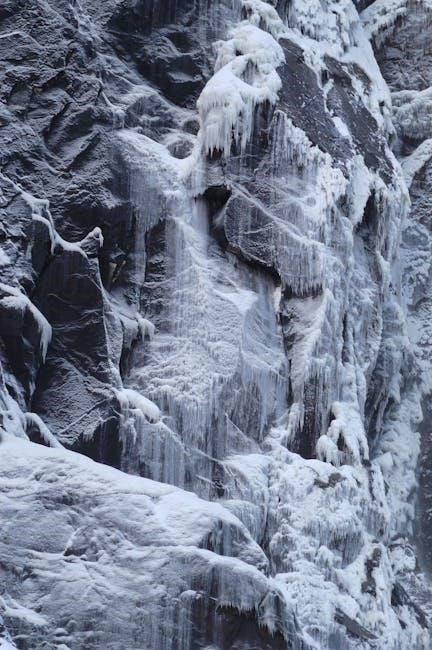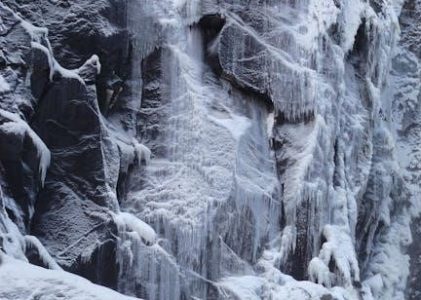Rocks are aggregates of minerals formed through geological processes. Minerals are naturally occurring solids with specific structures. Together, they compose the Earth’s crust, essential for understanding its composition and history.
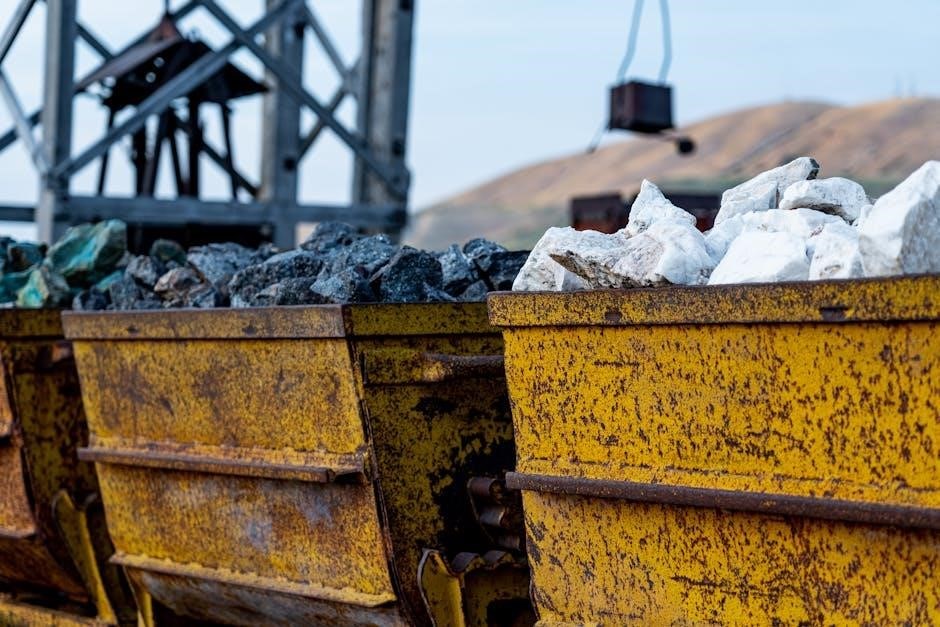
Definition of Rocks and Minerals
A rock is a naturally occurring solid mass of mineral material. Minerals are pure substances with a specific chemical composition and a crystalline structure. Rocks are composed of one or more minerals, which are inorganic and formed through geological processes. Minerals are defined by their unique physical properties, such as color, hardness, and crystal form. Rocks and minerals are fundamental to understanding Earth’s structure and history, as they provide insights into its formation and evolution over time.
The Importance of Studying Rocks and Minerals
Studying rocks and minerals is crucial for understanding Earth’s composition and history. They provide insights into geological processes, aiding in the discovery of natural resources like metals, fossil fuels, and minerals. This knowledge supports economic development, environmental sustainability, and construction industries. Rocks and minerals also help scientists predict natural hazards, such as earthquakes and volcanic eruptions, and understand climate change. Their study enhances our ability to locate and extract resources responsibly, ensuring sustainable use for future generations while preserving the planet’s natural heritage.

Types of Rocks
Rocks are solid aggregates of minerals, classified by origin or composition. They form the Earth’s crust and are key to understanding its history and structure.
Igneous Rocks
Igneous rocks form from the cooling and solidification of magma or lava. They can originate beneath the Earth’s surface (intrusive) or above it (extrusive). Intrusive rocks, like granite, cool slowly, forming large crystals, while extrusive rocks, like basalt, cool quickly, resulting in fine-grained textures. These rocks provide insights into Earth’s internal processes and are crucial for understanding volcanic activity and the planet’s thermal evolution.
Sedimentary Rocks
Sedimentary rocks are formed through the accumulation and compression of sediments, such as mineral particles or organic matter. These rocks develop in layers, often preserving fossils that provide insights into Earth’s history. Common types include sandstone, shale, and limestone. They form through processes like erosion, deposition, and lithification. Sedimentary rocks are significant as they often contain natural resources, such as oil, gas, and coal, making them vital for human use and economic activities.
Metamorphic Rocks
Metamorphic rocks form when existing rocks are transformed by high temperatures and pressures, without melting. This process alters their mineral composition and structure, creating new textures. Examples include marble and slate. These rocks provide valuable information about Earth’s tectonic activity and mountain-building processes. They are often rich in minerals like quartz and feldspar, which are crucial for industrial applications. Metamorphic rocks are key to understanding geological history and the Earth’s internal forces. Their study aids in locating mineral resources and comprehending Earth’s dynamic processes.
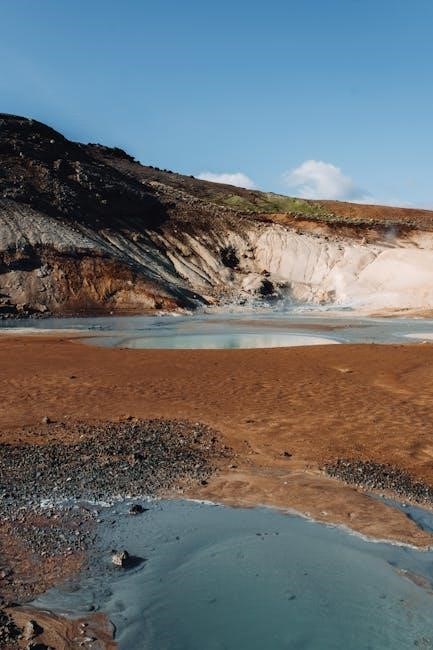
Rock-Forming Minerals
Rock-forming minerals are the primary components of rocks, forming the Earth’s crust. Common examples include quartz, feldspar, and mica. They determine a rock’s physical properties and composition.
Silicate Minerals
Silicate minerals are the most abundant group of minerals, comprising over 90% of the Earth’s crust. They are formed from silicon and oxygen atoms, often combined with metals. Key examples include quartz, feldspar, and mica. These minerals are essential in igneous, sedimentary, and metamorphic rocks, contributing to their structure and properties. Silicates exhibit a wide range of hardness, cleavage, and colors, making them versatile in geological processes and industrial applications. Their complex crystal structures and chemical diversity make silicate minerals fundamental to understanding Earth’s geology and material composition.
Non-Silicate Minerals
Non-silicate minerals lack silicon-oxygen bonds, distinguishing them from silicate minerals. They include sulfides, oxides, carbonates, halides, and native elements. Examples are pyrite (FeS₂), magnetite (Fe₃O₄), and calcite (CaCO₃). These minerals form through diverse geological processes, such as magmatic, hydrothermal, or sedimentary activities. Non-silicates often have unique properties, like magnetism or fluorescence, and are vital in economic deposits for metals and industrial applications. Their compositions and structures vary widely, making them significant in understanding Earth’s geochemical diversity and resource extraction for human use.
Minerals and Their Properties
Minerals are naturally occurring inorganic substances with specific chemical compositions and ordered atomic structures. Their properties include crystal form, hardness, color, and luster, aiding in identification and classification.
Physical Properties of Minerals
Physical properties of minerals include hardness, cleavage, luster, streak, color, density, and crystal form. Hardness measures resistance to scratching, while cleavage describes how minerals break along flat surfaces. Luster refers to the way light reflects off the surface, such as metallic or glassy. Streak is the color of the powder left on a porcelain plate. Density is mass per unit volume. Crystal form reveals the mineral’s internal structure. These properties help identify and classify minerals, making them essential for geological study and classification.
Chemical Composition of Minerals
Minerals are composed of one or more chemical elements in specific proportions. Their chemical composition determines their identity and properties. For example, quartz is made of silicon and oxygen, while feldspar contains sodium, potassium, or calcium. Minerals can be pure substances or combinations of elements in fixed ratios. Understanding their chemical makeup is crucial for identifying and classifying minerals, as it directly influences their physical properties and behavior. This composition also plays a key role in determining their geological formation and industrial applications, making it a fundamental aspect of mineralogy studies.
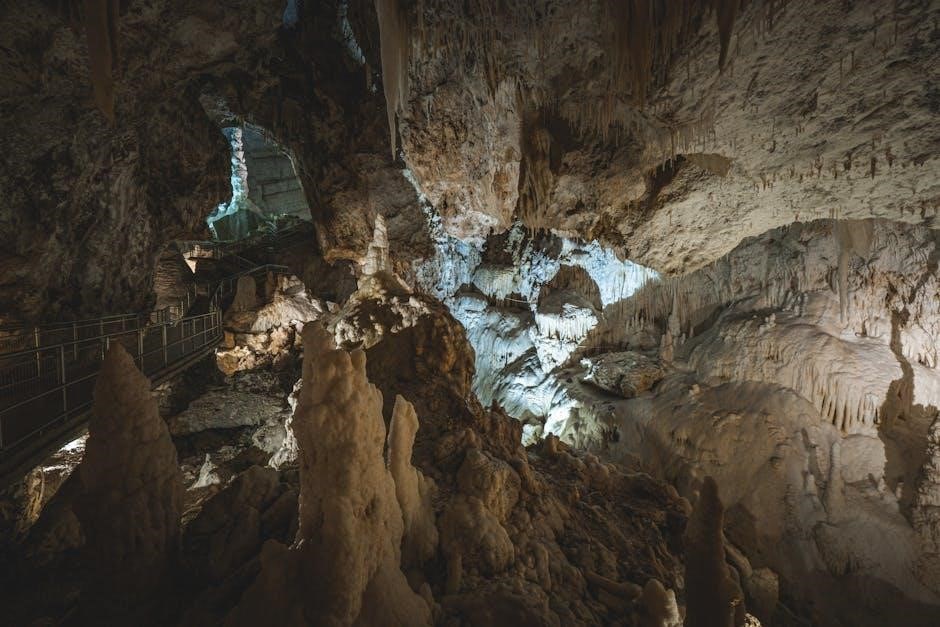
Uses of Rocks and Minerals
Rocks and minerals are vital in construction, technology, and manufacturing. They provide essential materials for buildings, electronics, and tools. Minerals like copper and quartz are indispensable in modern industries, while gemstones are prized for jewelry. Their unique properties make them irreplaceable in various applications, from energy production to everyday household items, showcasing their profound impact on human life and environmental sustainability.
Industrial Applications
Rocks and minerals are cornerstone resources in various industries. In construction, aggregates like sand and gravel are essential for concrete and asphalt. Minerals such as silica and quartz are critical in electronics for manufacturing semiconductors. Metals like copper and aluminum are pivotal in electrical wiring and machinery production. Additionally, limestone and dolomite are used in steelmaking and water treatment. Industrial applications leverage the unique properties of minerals to create vital materials, driving technological advancements and infrastructure development. These resources are indispensable for maintaining and improving modern industrial capabilities and environmental sustainability practices. Their versatility ensures widespread use across multiple sectors.
Everyday Uses
Rocks and minerals are integral to daily life, appearing in numerous household and personal items. Granite and marble are used for countertops, while quartz is prized in jewelry. Minerals like talc and silica are found in cosmetics and skincare products. Rocks such as limestone and sandstone are used in construction for buildings and roads. Additionally, minerals like salt and gypsum are essential in food preservation and plaster production. Even everyday tools, such as knives and drills, rely on minerals like diamond and tungsten for durability. These resources are indispensable in modern living, contributing to both functionality and aesthetics.
Identifying Rocks and Minerals
Identifying rocks and minerals involves analyzing physical properties, chemical composition, and structural features. Techniques include hardness testing, density measurement, and examining crystal formations under magnification.
Rock Identification Techniques
Rock identification involves examining physical properties such as texture, color, and hardness. Techniques include visual inspection, density measurement, and chemical testing. A hand lens helps observe mineral grains, while acid tests reveal carbonate presence. Streak tests determine mineral color, and hardness is assessed using the Mohs scale. Magnetic tests identify ferromagnetic minerals. These methods, often combined, provide a comprehensive understanding of rock composition and origin, aiding geologists in classification and analysis. Proper safety equipment, like gloves and goggles, is essential during fieldwork to ensure safe and accurate identification processes.
Mineral Identification Methods
Mineral identification involves analyzing physical and chemical properties. Techniques include streak testing to determine color, hardness testing using the Mohs scale, and acid tests for carbonates. Magnetic tests identify ferromagnetic minerals, while specific gravity measures density. Crystal shape and luster are also examined. Chemical analysis, like X-ray diffraction, reveals composition. These methods help distinguish minerals accurately. Safety gear, such as gloves and goggles, is essential during testing to handle potentially hazardous reactions or sharp mineral edges effectively.
The Environmental Impact of Rocks and Minerals
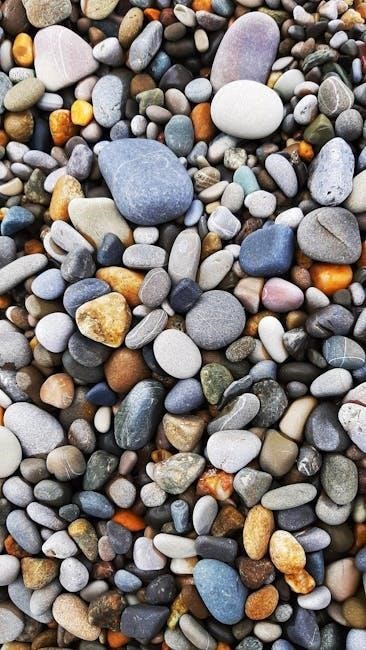
Mining and drilling for rocks and minerals can harm ecosystems, causing deforestation, water contamination, and habitat loss. Sustainable practices and conservation are crucial to mitigate these effects.
Human Activities and Rock/Mineral Resources
Human activities, such as mining and drilling, significantly impact rock and mineral resources. These practices often lead to environmental degradation, including deforestation and water contamination. The extraction of resources like copper, gypsum, and rare metals supports industries but can disrupt ecosystems. Sustainable practices are essential to balance resource exploitation with environmental preservation. Conservation efforts aim to minimize the ecological footprint of mining while ensuring the long-term availability of these vital materials for future generations.
Sustainability and Conservation
Sustainability in rock and mineral use focuses on responsible extraction and efficient resource management. Conservation efforts aim to protect natural reserves from overexploitation, ensuring their availability for future generations. Recycling and reusing minerals are key strategies to reduce environmental impact. Advanced technologies are employed to minimize waste and optimize extraction processes. Additionally, educational campaigns promote awareness about the importance of preserving geological resources. These practices help maintain ecological balance while meeting the demands of industrial and societal needs sustainably.
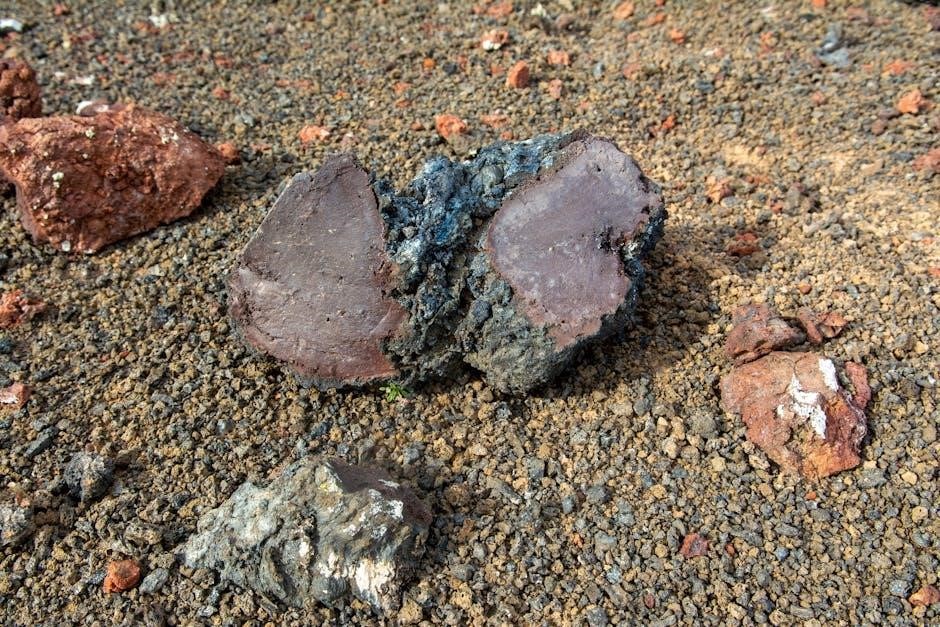
Collecting Rocks and Minerals
Collecting rocks and minerals is a popular hobby, offering both recreational enjoyment and educational value, dating back to the 19th century, sparking curiosity about Earth’s composition and geological history.
Safety Tips for Collecting
When collecting rocks and minerals, prioritize safety by wearing protective gear, including sturdy shoes, gloves, and eyewear. Ensure you have legal access to collection sites and obtain necessary permits. Avoid dangerous locations like unstable cliffs or restricted areas. Be mindful of environmental impact and avoid damaging habitats. Bring essential tools like a rock hammer, hand lens, and first-aid kit. Stay informed about local regulations and weather conditions to ensure a safe and enjoyable experience while preserving natural resources for future generations.
Best Practices for Rockhounding
Plan your rockhounding adventure by researching locations and obtaining necessary permits. Use appropriate tools like a rock hammer, chisels, and hand lens to collect specimens carefully. Always follow ethical collecting practices, ensuring minimal environmental impact and adhering to local laws. Document your finds with notes and photos for future reference. Respect private property and sensitive habitats, leaving sites in their natural state. Engage with the rockhounding community to share knowledge and learn from experienced collectors. Stay updated on new discoveries and techniques to enhance your hobby and appreciation for geology.
